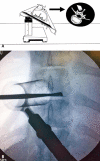Minimally invasive swine spine surgery training: technical aspects, benefits, and anatomical limitations
- PMID: 35195190
- PMCID: PMC8809647
- DOI: 10.31744/einstein_journal/2022AO6318
Minimally invasive swine spine surgery training: technical aspects, benefits, and anatomical limitations
Abstract
Objective: To describe the technical specificities and feasibility of simulation of minimally invasive spine surgery in live pigs, as well as similarities and differences in comparison to surgery in humans.
Methods: A total of 22 Large White class swine models, weighing between 60 and 80kg, were submitted to surgical simulations, performed during theoretical-practical courses for training surgical techniques (microsurgical and endoscopic lumbar decompression; percutaneous pedicular instrumentation; lateral access to the thoracic spine, and anterior and retroperitoneal to the lumbar spine, and management of complications) by 86 spine surgeons. For each surgical technique, porcine anatomy (similarities and differences in relation to human anatomy), access route, and dimensions of the instruments and implants used were evaluated. Thus, the authors describe the feasibility of each operative simulation, as well as suggestions to optimize training. Study results are descriptive, with figures and drawings.
Results: Neural decompression surgeries (microsurgeries and endoscopic) and pedicular instrumentation presented higher similarities to surgery on humans. On the other hand, intradiscal procedures had limitations due to the narrow disc space in swines. We were able to simulate situations of surgical trauma in surgical complication scenarios, such as cerebrospinal fluid fistulas and excessive bleeding, with comparable realism to surgery on humans.
Conclusion: A porcine model for simulation of minimally invasive spinal surgical techniques had similarities with surgery on humans, and is therefore feasible for surgeon training.
Conflict of interest statement
Figures





References
-
- Tan SS, Sarker SK. Simulation in surgery: a review. Scott Med J. 2011;56(2):104-9. Review. - PubMed
-
- Lu VM, Kerezoudis P, Gilder HE, McCutcheon BA, Phan K, Bydon M. Minimally Invasive Surgery Versus Open Surgery Spinal Fusion for Spondylolisthesis: a systematic review and meta-analysis. Spine (Phila Pa 1976). 2017;42(3):E177-85. Review. - PubMed
-
- Wolfe BM, Szabo Z, Moran ME, Chan P, Hunter JG. Training for minimally invasive surgery. Surg Endosc.1993;7:93-5. - PubMed
-
- Dawe S, Windsor J, Cregan P, Hewett P, Maddern G. Surgical simulation for training: skills transfer to the operating room (update). ASERNIP-S report no. 80 (update of ASERNIP-S report no. 61). Australia: ASERNIP-S; 2012 [cited 2021 Mayo 11]. Available from: https://umbraco.surgeons.org/media/2729/rpt_2012-11-21_surgical_simulati...
MeSH terms
LinkOut - more resources
Full Text Sources

